Archive:Information society statistics
- Data from September 2010, most recent data: Further Eurostat information, Main tables and Database.
This article presents recent statistical data on many different aspects of the information society in the European Union (EU). Progress in the development of the information society is regarded as critical to improve the competitiveness of EU industry and, more generally, to meet the demands of society and the EU economy.
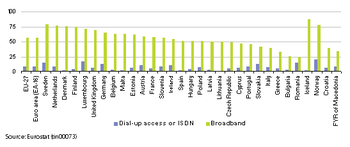
(% of all households) - Source: Eurostat (tin00073)
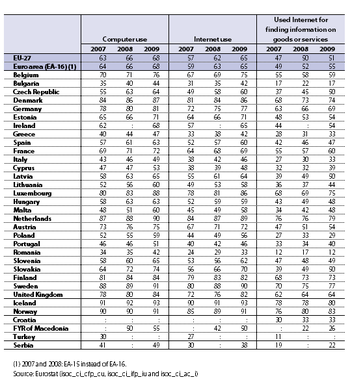
(% of individuals aged 16 to 74) - Source: Eurostat (isoc_ci_cfp_cu), (isoc_ci_cfp_iu) and (isoc_ci_ac_i)
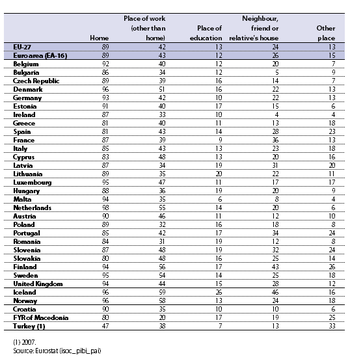
(% of individuals aged 16 to 74 who used the Internet in the three months prior to the survey) - Source: Eurostat (isoc_ci_cfp), (isoc_ci_ifp_iu) and (isoc_ci_ac_i)
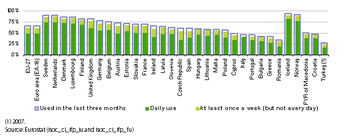
(% of individuals aged 16 to 74) - Source: Eurostat (isoc_ci_ifp_iu) and (isoc_ci_ifp_fu)
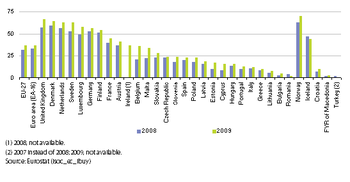
(% of individuals aged 16 to 74) - Source: Eurostat (isoc_ec_ibuy)
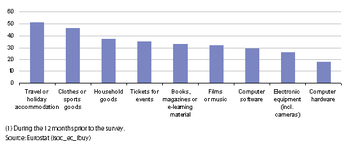

(% of individuals not buying or ordering over the Internet) - Source: Eurostat (isoc_ec_inb)
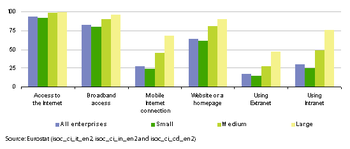
(% of enterprises) - Source: Eurostat (isoc_ci_it_en2), (isoc_ci_in_en2) and (isoc_ci_cd_en2)
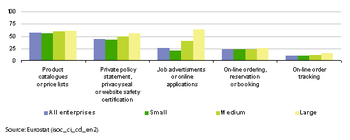
(% of enterprises having a website) - Source: Eurostat (isoc_ci_cd_en2)

(%) - Source: Eurostat (isoc_ec_evaln2), (isoc_ec_ebuyn2) and (isoc_ec_eseln2)
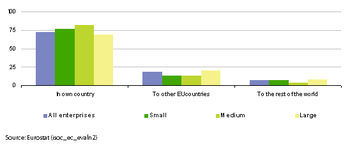
(% of turnover from e-commerce) - Source: Eurostat (isoc_ec_evaln2)
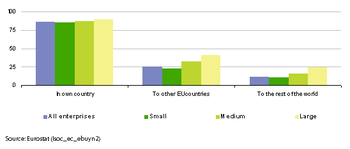
(% of enterprises sending e-commerce orders) - Source: Eurostat (Isoc_ec_ebuyn2)
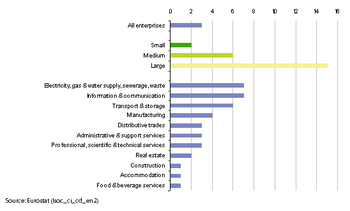
(% of enterprises) - Source: Eurostat (Isoc_ci_cd_en2)
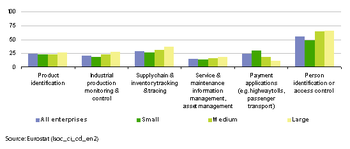
(% of enterprises using RFID) - Source: Eurostat (Isoc_ci_cd_en2)
Information and communication technologies (ICT) affect people's everyday lives in many ways, both at work and in the home, and EU policies in this area range from regulating entire sectors to trying to protect an individual's privacy.
Main statistical findings
Households and individuals
During the last decade, ICT have become widely available to the general public, both in terms of accessibility as well as cost. A boundary was crossed in 2007, when a majority (54 %) of households across the EU-27 had Internet access. This proportion has continued to increase and in 2009 reached 65 %. The highest proportion (90 %) of households with Internet access in 2009 was recorded in the Netherlands, the lowest (30 %) in Bulgaria (see Figure 1). Widespread and affordable broadband access is one of the means of promoting a knowledge-based and informed society. In all Member States broadband was by far the most common form of Internet access (an average of 56 % of all EU-27 households in 2009 compared with 8 % of households that used dial-up access or ISDN access).
Slightly more than two thirds (68 %) of individuals in the EU-27, aged between 16 and 74 years, used a computer in the three months before the 2009 ICT survey, while a similar proportion (65 %) used the Internet. The proportion of individuals using a computer and the Internet in the three months before the 2009 survey rose to around 90 % in Sweden and the Netherlands, but was in a minority in Bulgaria, Greece, Italy, and particularly in Romania. Furthermore, half (51 %) of the individuals in the EU-27 used the Internet for finding information on goods or services in 2009, the spread among Member States being from less than 20 % in Bulgaria and Romania to more than 70 % in the Netherlands, Sweden, Luxembourg, Denmark and Finland (see Table 1).
Among Internet users, in other words, those individuals within the EU-27 using the Internet in the three months before the ICT survey, a large majority (89 %) accessed the Internet from home, as shown in Table 2. By comparison, less than half of this subset of the population accessed the Internet at work (42 %), which in turn was around double the proportion accessing the Internet from a friend's, neighbour's or relative’s house (24 %). Of the 65 % of individuals in the EU-27 that used the Internet in the three months before the 2009 ICT survey, nearly three quarters accessed the Internet on a daily or almost daily basis.
Just over one third (37 %) of individuals in the EU-27 ordered goods or services over the Internet for private use during the year prior to the 2009 survey, an increase of 5 percentage points compared with the year before (see Figure 4). This proportion reached close to two thirds in the United Kingdom, Denmark, the Netherlands and Sweden, whereas no more than one in ten persons made orders over the Internet in Greece, Lithuania, Bulgaria or Romania. Among persons who had not bought or ordered products over the Internet, the main reasons given for not doing so were that they preferred to shop in person or that they had no need. More than one third (35 %) had security concerns related to payment, while the next most common reasons were privacy concerns (29 %) and concerns related to trust (26 %).
Enterprises
About six in every ten enterprises (64 %) in the EU-27 had their own website in 2009, and this proportion rose to 90 % among large enterprises (see Figure 7). Most commonly enterprise’s websites were used to provide product catalogues or price lists, this being the case for 57 % of enterprises with websites, a share that did not change greatly between enterprises of different sizes (see Figure 8). In contrast, around one fifth (21 %) of small enterprises with websites used them to advertise jobs or accept applications, whereas this was done by over three fifths (63 %) of large enterprises.
Some 11 % of enterprises in the EU-27 received orders on-line during 2009, which was about half the proportion of enterprises (23 %) that made purchases on-line (see Figure 9). The percentage of enterprises selling or purchasing on-line tends to rise with the size of the enterprise; it may be easier for large enterprises to finance investments for the introduction of e-commerce services. In total, e-commerce accounts for around 10 % of turnover among enterprises with at least ten persons employed in the EU-27, a share that ranged from 4 % for small enterprises to 17 % for large enterprises. Close to three quarters (72 %) of e-commerce turnover was generated from sales to enterprises in the seller’s own country, with 8 % from sales outside of the EU.
In the EU-27 in January 2009, 3 % of enterprises with at least ten persons employed (excluding those in the financial sector) used radio frequency identification (RFID), a share that rose to 15 % for large enterprises, as shown in Figure 12. This technology was used for a wide variety of purposes, most commonly for person identification or access control (55 % of enterprises using RFID). The next most common purposes were for inventory tracking and tracing, for payment (such as for motorway tolls) and for product identification (see Figure 13).
Data sources and availability
Statisticians are well aware of the challenges posed by rapid technological change in areas related to the Internet and other new applications of ICTs. As such, there has been a considerable degree of evolution in this area, with statistical tools being adapted to satisfy new demands for data. Statistics within this domain are reassessed on an annual basis in order to meet user needs and reflect the rapid pace of technological change.
This approach is reflected in Eurostat’s survey on ICT usage in households and by individuals, and Eurostat’s survey on ICT usage in enterprises. These annual surveys can be used to benchmark ICT-driven developments, both by following developments for core variables over time, as well as by looking in greater depth at other aspects at a specific point in time. While the surveys initially concentrated on access and connectivity issues, their scope has subsequently been extended to cover a variety of subjects (for example, e-government and e-commerce) and socio-economic breakdowns, such as regional diversity, gender specificity, age, educational differences and the individual’s employment situation in the household survey, or a breakdown by enterprise size (small, medium-sized, large) in the enterprise survey. The scope of the surveys with respect to different technologies is also adapted so as to cover new product groups and means of delivering communication technologies to end-users (enterprises and households).
Households and individuals
Included are households having at least one member in the age group 16 to 74 years old. Internet access of households refers to the percentage of households that have an Internet access, so that anyone in the household could use the Internet at home, if so desired, even simply to send an e-mail. Internet users are defined as all individuals aged 16-74 who had used the Internet in the three months prior to the survey. Regular Internet users are individuals who used the Internet, on average, at least once a week in the three months prior to the survey.
The technologies most commonly used to access the Internet are divided between broadband and dial-up access. Broadband includes digital subscriber lines (DSL) and uses technology that transports data at high speeds. Broadband lines are defined as having a capacity equal to or higher than 144 kbit/s. A dial-up access using a modem can be made over a normal or an ISDN telephone line and, due to its limited bandwidth, it is often referred to as narrowband.
A computer is defined as a personal computer powered by one of the major operating systems (Macintosh, Linux or Microsoft); handheld computers or palmtops (PDAs) are also included.
The ordering of goods and services by individuals includes confirmed reservations for accommodation, purchasing financial investments, participation in lotteries and betting, Internet auctions, as well as information services from the Internet that are directly paid for. Goods and services that are obtained via the Internet for free are excluded. Orders made by manually written e-mails are also excluded.
Enterprises
The survey on ICT usage and e-commerce in enterprises covers enterprises that have at least ten persons employed. The activity coverage is restricted to those enterprises whose principal activity is within manufacturing, electricity, gas, steam and water supply, sewerage and waste management, construction, wholesale and retail trade, repair of motor vehicles and motorcycles, transportation and storage, accommodation and food service activities, information and communication, real estate, professional, scientific and technical activities, administrative and support activities (NACE Rev. 2 Sections C to N excluding Division 75). The financial and insurance activities (Section K) are covered by the survey but are excluded from the analysis presented here. A distinction is made according to the size of enterprises in terms of persons employed into small (10-49 persons employed), medium-sized (50-249) and large (250 or more persons employed) enterprises.
ICT usage data in tables and databases on the Eurostat website are grouped according to the year in which the survey was conducted; most data refer to the situation in January whereas some others (like e-commerce) refer to the calendar year prior to the survey year.
Radio frequency identification (RFID) is a technology which uses special tags to remotely retrieve data by radio waves. This technology is used, among other uses, to keep track of freight passing through a cargo terminal, to monitor inventory, as a payment system for motorways and bridges or to identify and control access of persons.
Context
Information and communication technologies (ICT) are considered as critical for improving the competitiveness of European industry and, more generally, to meet the demands of society and the economy. ICT affects many aspects of everyday lives, at both work and in the home, and EU policies in this area range from the regulation of entire sectors to the protection of an individual’s privacy.
Broadband technologies are considered to be important when measuring access to and use of the Internet, as they offer users the possibility to rapidly transfer large volumes of data and keep access lines open. The take-up of broadband is considered to be a key indicator within the domain of ICT policy-making. Widespread access to the Internet via broadband is seen as essential for the development of advanced services on the Internet, such as e-business, e-government or e-learning. Digital subscriber lines (DSL) remain the main form of delivery for broadband technology, although alternatives, such as the use of cable, satellite, fibre optics and wireless local loops are becoming more widespread.
Since 2005 the EU policy framework for ICT has been the i2010 initiative called ‘A European information society for growth and employment’ (COM(2005) 229 final) which sought to boost efficiency throughout the EU economy by means of the wider use of ICT. Having undergone a mid-term review, an updated i2010 strategy was presented in April 2008, addressing key challenges for the period 2008-2010.
In May 2010 the European Commission adopted its Communication concerning a ‘Digital Agenda for Europe’ (COM(2010) 245 final), a strategy for a flourishing digital economy by 2020. It outlines policies and actions aimed at maximising the benefit of the digital era to all sections of society and economy. The agenda focuses on seven priority areas for action: creating a digital single market, greater interoperability, boosting Internet trust and security, providing much faster Internet access, encouraging investment in research and development, enhancing digital literacy skills and inclusion, and applying ICT to address challenges facing society like climate change and the ageing population. Examples of benefits include easier electronic payments and invoicing, rapid deployment of telemedicine and energy efficient lighting. The digital agenda for Europe was the first of seven flagship initiatives under the Europe 2020 strategy for smart, sustainable and inclusive growth.
Further Eurostat information
Publications
- Science, technology and innovation in Europe
- Science, technology and innovation in Europe – 2011 edition - Pocketbook
Main tables
- Information society, see:
- Information society statistics
- Policy indicators (t_isoc_pi)
- Information society: Structural Indicators (t_isoc_si)
- Telecommunication services (t_isoc_tc)
- Computers and the Internet in households and enterprises (t_isoc_ci)
- E-skills of individuals and ICT competence in enterprises (t_isoc_sk)
Database
- Information society, see:
- Information society statistics
- Policy indicators (isoc_pi)
- Information society: Structural Indicators (isoc_si)
- Telecommunication services (isoc_tc)
- Computers and the Internet in households and enterprises (isoc_ci)
- E-commerce by individuals and enterprises (isoc_ec)
- E-skills of individuals and ICT competence in enterprises (isoc_sk)
- Regional Information society statistics (isoc_reg)
Dedicated section
Methodology / Metadata
- Computers and the Internet in households and enterprises (ESMS metadata file - isoc_ci_esms)
- E-commerce by individuals and enterprises (ESMS metadata file - isoc_ec_esms)
- E-skills of individuals and ICT competence in enterprises (ESMS metadata file - isoc_sk_esms)
- Policy indicators (ESMS metadata file - isoc_pi_esms)
- Regional Information society statistics (ESMS metadata file - isoc_reg_esms)
- Telecommunication services (ESMS metadata file - isoc_tc_esms]
